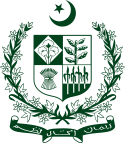
Back President de Pakistán AN رئيس باكستان Arabic رئيس باكستان ARZ Presidente de Paquistán AST Pakistan Prezidenti Azerbaijani পাকিস্তানের রাষ্ট্রপতি Bengali/Bangla President del Pakistan Catalan سەرۆک کۆماری پاکستان CKB Prezident Pákistánu Czech ޕާކިސްތާނުގެ ރައީސް DV
| President of Pakistan | |
|---|---|
| صدرِ پاکستان | |
 | |
 | |
since 10 March 2024 | |
| Head of state of the Islamic Republic of Pakistan Executive branch of the Government of Pakistan | |
| Style | Honourable President (formal) His Excellency[1] (diplomatic) Mr President (informal) |
| Type | Head of state Commander-in-chief |
| Residence | Aiwan-e-Sadr, Red Zone, Islamabad-44040 |
| Seat | Aiwan-e-Sadr, Red Zone, Islamabad-44040 |
| Appointer | Electoral College |
| Term length | Five years (Renewable once) |
| Constituting instrument | Constitution of Pakistan |
| Precursor | Monarch of Pakistan |
| Inaugural holder | Iskander Mirza |
| Formation | 23 March 1956 |
| Succession | Line of succession |
| Deputy | Chairman of the Senate |
| Salary | ₨846,550 per month[2][3] |
| Website | President of Pakistan |
 |
|---|
|
|
The president of Pakistan (Urdu: صدرِ پاکستان, romanized: s̤adr-i Pākistān) is the head of state of the Islamic Republic of Pakistan. The president is the nominal head of the executive and the supreme commander of the Pakistan Armed Forces.[4][5] The presidency is a ceremonial position in Pakistan. The president is bound to act on advice of the prime minister and cabinet. Asif Ali Zardari is the current president since 10 March 2024.
The office of president was created upon the proclamation of Islamic Republic on 23 March 1956. The then serving governor-general, Major General Iskander Mirza, assumed office as the first president. Following the 1958 coup d'etat, the office of prime minister was abolished, leaving the Presidency as the most powerful office in the country. This position was further strengthened when the 1962 Constitution was adopted. It turned Pakistan into a Presidential Republic, giving all executive powers to the president. In 1973, the new Constitution established Parliamentary democracy and reduced the president's role to a ceremonial one. Nevertheless, the military takeover in 1977 reversed the changes. The 8th Amendment turned Pakistan into a semi-presidential republic and in the period between 1985 and 2007, the executive power was shared by the president and prime minister. The 18th Amendment in 2010 restored Parliamentary Democracy in the country, and reduced the presidency to a ceremonial position.[6]
The constitution prohibits the president from directly running the government.[7] Instead, the executive power is exercised on his behalf by the prime minister who keeps him informed on all matters of internal and foreign policy, as well as all legislative proposals.[8] The Constitution however, vests the president with the powers of granting pardons, reprieves, and the control over military; however, all appointments at higher commands of the military must be made by the President on a "required and necessary" basis, upon consultation and approval from the prime minister.[9]
The president is indirectly elected by the Electoral College for a five-year term. The Constitution requires the president to be a "Muslim of not less than forty five (45) years of age". The president resides in an estate in Islamabad known as Aiwan-e-Sadar (President's House). In his absence, the chairman of Senate exercises the responsibilities of the post, until the actual president resumes office, or the next office holder is elected.
There have been a total of 14 presidents. The first president was Iskander Ali Mirza who entered office on 23 March 1956. The current office holder is Asif Ali Zardari, who took charge on 9 March 2024, following his controversial victory in the 2024 elections.[a]
- ^ Gupta, K. R., ed. (2006). India-Pakistan relations with special reference to Kashmir. New Delhi: Atlantic Publ. and Distributors. ISBN 8126906723.
- ^ "Govt wants to double president's salary". The Express Tribune. 29 May 2018.
- ^ "Data" (PDF). www.na.gov.pk. Retrieved 9 June 2020.
- ^ Article 243(3) Archived 2015-03-21 at the Wayback Machine in Chapter 2: The Armed Forces. Part XII: Miscellaneous in the Constitution of Pakistan.
- ^ Article 41(1) Archived 2016-02-04 at the Wayback Machine in Chapter 1: The President, Part III: The Federation of Pakistan in the Constitution of Pakistan.
- ^ "Pakistan moves to roll back presidential powers". Los Angeles Times. 2 April 2010.
- ^ Article 43(1)–43(2) Archived 2016-02-04 at the Wayback Machine in Chapter 1: The President, Part III: The Federation of Pakistan in the Constitution of Pakistan.
- ^ Article 46 Archived 2016-02-04 at the Wayback Machine in Chapter 1: The President, Part III: The Federation of Pakistan in the Constitution of Pakistan.
- ^ Article 243(2) Archived 2015-03-21 at the Wayback Machine in Chapter 2: The Armed Forces. Part XII: Miscellaneous in the Constitution of Pakistan.
Cite error: There are <ref group=lower-alpha> tags or {{efn}} templates on this page, but the references will not show without a {{reflist|group=lower-alpha}} template or {{notelist}} template (see the help page).


